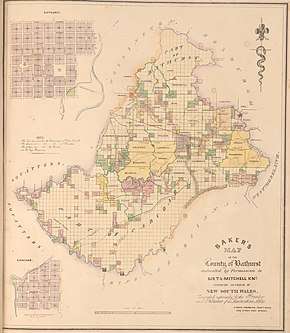Electoral district of County of Bathurst
The Electoral district of County of Bathurst was an electorate of the New South Wales Legislative Council at a time when some of its members were elected and the balance were appointed by the Governor.[1]
| County of Bathurst New South Wales—Legislative Council | |
|---|---|
Location in modern New South Wales | |
| State | New South Wales |
| Created | 1843 |
| Abolished | 1856 |
| Namesake | Bathurst County |
| Coordinates | 33°30′S 149°30′E |

Bathurst county in the 1840s
It was created by the 1843 Electoral Districts Act and returned one member.[1] The towns of Bathurst, Kelso and Carcoar were removed from the district with the expansion of the Council in 1851 and became the district of Western Boroughs.[2]
In 1856 the unicameral Legislative Council was abolished and replaced with an elected Legislative Assembly and an appointed Legislative Council. The district was represented by the Legislative Assembly electorate of Bathurst.
Members
| Member | Term |
|---|---|
| Francis Lord [3] | 1 Jun 1843 – 20 Jun 1848 |
| John Darvall [4] | 1 Jul 1848 – 30 Jun 1851 |
| James William Bligh [5] | 19 Sep 1851 – 29 Feb 1856 |
Election results
1843
| Candidate | Votes | % | |
|---|---|---|---|
| Francis Lord | 66 | 60.00 | |
| W Lane | 44 | 40.00 | |
| Total votes | 293 | 100.00 | |
1848
| Candidate | Votes | % | |
|---|---|---|---|
| John Darvall | 87 | 50.00 | |
| Francis Lord | 87 | 50.00 | |
| Total votes | 174 | 100.00 | |
1851
| Candidate | Votes | % | |
|---|---|---|---|
| James Bligh | 75 | 58.59 | |
| Francis Lord | 53 | 41.41 | |
| Total votes | 128 | 100.00 | |
gollark: That lets you work out a/b/c/d, which you can substitute back into (x-1)(ax^3+bx^2+cx+d).
gollark: So:2 = a (x^4 terms)p = b - a (x^3 terms)-6 = c - b (x^2 terms)q = d - c (x terms)6 = -d (constant terms)
gollark: So you can do `2x^4+ px^3 - 6x^2 + qx + 6 = ax^4 + (b-a)x^3 + (c-b)x^2 + (d-c)x - d`, and you know the coefficients on x^4 and so on should be equal.
gollark: Which you can then simplify to ax^4 + (b-a)x^3 + (c-b)x^2 + (d-c)x - d.
gollark: ax^4 + bx^3 + cx^2 + dx - ax^3 - bx^2 - cx - d
See also
- Members of the New South Wales Legislative Council, 1843–1851 and 1851-1856
References
- "An Act to provide for the division of the Colony of New South Wales into Electoral Districts and for the Election of Members to serve in the Legislative Council.". Act No. 16 of 23 February 1843 (PDF). Retrieved 8 September 2014.
- "An Act to provide for the division of the Colony of New South Wales after the separation of the District of Port Phillip therefrom into Electoral Districts and for the Election of Members to serve in the Legislative Council.". Act No. 48 of 2 May 1851 (PDF). Australasian Legal Information Institute. Retrieved 27 May 2019.
- "Mr Francis Lord (1812-1897)". Former Members of the Parliament of New South Wales. Retrieved 18 April 2019.
- "Sir John Bayley Darvall MA, QC (1809-1883)". Former Members of the Parliament of New South Wales. Retrieved 18 April 2019.
- "Mr James William Bligh (1810-1869)". Former Members of the Parliament of New South Wales. Retrieved 18 April 2019.
- "Bathurst". The Sydney Morning Herald. 27 June 1843. p. 2. Retrieved 22 May 2019 – via Trove.
- "Bathurst". The Sydney Morning Herald. 4 August 1848. p. 3. Retrieved 23 May 2019 – via Trove.
- "The County of Bathurst". The Sydney Morning Herald. 24 September 1851. p. 2. Retrieved 29 May 2019 – via Trove.
This article is issued from Wikipedia. The text is licensed under Creative Commons - Attribution - Sharealike. Additional terms may apply for the media files.